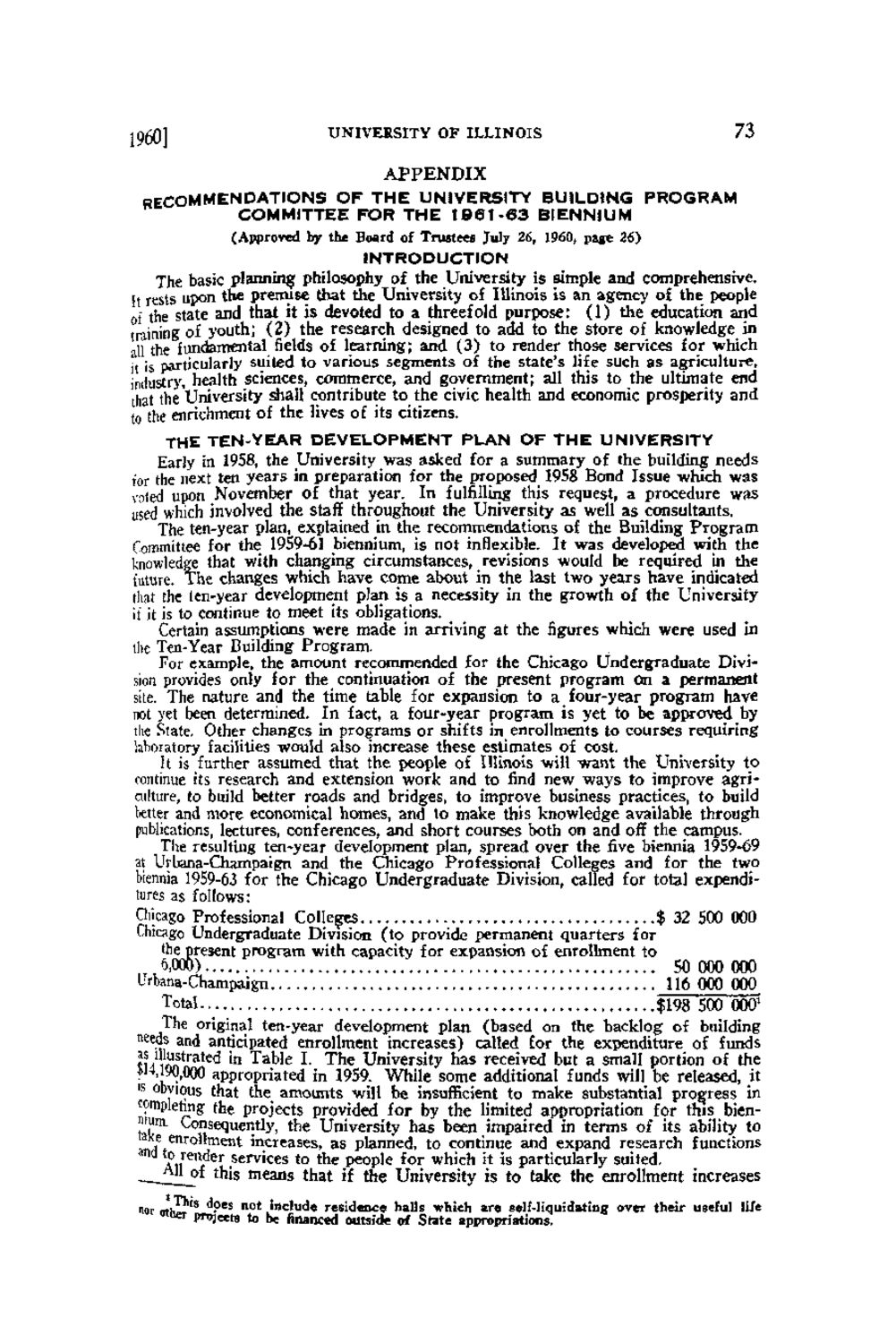| |
| |
Caption: Board of Trustees Minutes - 1962
This is a reduced-resolution page image for fast online browsing.

EXTRACTED TEXT FROM PAGE:
i960] UNIVERSITY OF ILLINOIS 73 APPENDIX RECOMMENDATIONS O F T H E UNIVERSITY BUILDING PROGRAM COMMITTEE FOR THE 1 8 6 1 - 6 3 BIENNIUM (Approved by *"* Beard of Trustees July 26, 1960, pig* 26) INTRODUCTION The basic planning philosophy of the University is simple and comprehensive. (t rests upon the premise that the University of Illinois is an agency of the people of the state and thai it is devoted to a threefold purpose: (1) the education and training of youth; (2) the research designed to add to the store of knowledge in all the fundamental fields of learning; and (3) to render those services for which j t is particularly suited to various segments of the state's life such as agriculture, industry, health sciences, commerce, and government; all this to the ultimate end that the University shall contribute to the civic health and economic prosperity and to the enrichment of the lives of its citizens. THE TEN-YEAR DEVELOPMENT PLAN OF T H E UNIVERSITY Early in 1958, the University was asked for a summary of the building needs tor the next ten years in preparation for the proposed 1958 Bond Issue which was vaied upon November of that year. In fulfilling this request, a procedure was used which involved the staff throughout the University as well as consultants. The ten-year plan, explained in the recommendations of the Building Program Committee for the 1959-61 biennium, is not inflexible. It was developed with the knowledge that with changing circumstances, revisions would be required in the tuture. The changes which have come about in the last two years have indicated that the len-year development plan is a necessity in the growth of the University it it is to continue to meet its obligations. _ Certain assumptions were made in arriving at the figures which were used in ilie Ten-Year Building Program. For example, the amount recommended for the Chicago Undergraduate Division provides only for the continuation of the present program On a permanent site. The nature and the time table for expansion to a four-year program have not yet been determined. In fact, a four-year program is yet to be approved by the State, Other changes in programs or shifts in enrollments to courses requiring Moratory facilities would also increase these estimates of cost. It is further assumed that the people of Illinois will want the University to rontinue its research and extension work and to find newways to improve agriculture, to build better roads and bridges, to improve business practices, to build better and more economical homes, and to make this knowledge available through publications, lectures, conferences, and short courses both on and off the campus. The resulting ten-year development plan, spread over the five biennia 1959-69 at Urlana-Champaign and the Chicago Professional Colleges and for the two biennia 1959-63 for the Chicago Undergraduate Division, called for total expenditures as follows: Oficago Professional Colleges $ 32 500 000 Chicago Undergraduate Division (to provide permanent quarters for the present program with capacity for expansion of enrollment to WW) 50 000 000 Lrkna-Champaign 116 O P 000 O Total $198 500 0001 The original ten-year development plan, (based on the backlog of building feeds and anticipated enrollment increases) called for the expenditure of funds 1\A ifjftra,e^ ln Table I. The University has received but a small portion of the •14,190,000 appropriated in 1959. While some additional funds will be released, it is obvious that die amounts will be insufficient to make substantial progress in completing seouen tl the projects provided for by the limited appropriation for this bienfcA ( ^?? , y. the University has been impaired in terms of its ability to ™e enrollment increases, as planned, to continue and expand research functions re f services t o t n e Aii "jk . People for which it is particularly suited, ___2]lj>f this means that if the University is to take the enrollment increases nor ath ^ ° e s n o t ' n c t u d« residence halls which are self-liquidating over their useful life •»uer projects to be financed outside (rf Slate appropriations.
| |